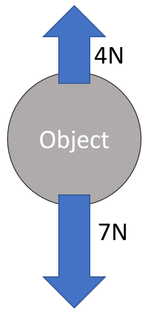Unbalanced Forces
Contents
Key Stage 3
Meaning
Unbalanced Forces are Forces acting in opposite directions with different magnitudes.
About Unbalanced Forces
- When there are unbalanced forces on an object the object will accelerate.
| The 4N up and the 7N down mean the object will accelerate downwards due to a resultant force of 3N. | The 4N left and the 3N right mean the object will accelerate to the left due to a resultant force of 1N. | The 6N up is balanced by the 6N down but the 6N left and the 4N right mean the object will accelerate to the left due to a resultant force of 2N. |
Key Stage 4
Meaning
Unbalanced forces are force vectors which add together to make a (non-zero) resultant force.
About Balanced Forces
- When forces on an object are unbalanced it will accelerate (change speed or direction).
- Unbalanced forces are related to Newton's First Law of motion:
- An object in motion will tend to stay in motion in a straight line and an object at rest will tend to stay at rest unless an unbalanced force acts upon it.
- If the resultant force on an object is not zero, then the forces are unbalanced.
Examples
|
Choose which directions are positive. Up is positive. Calculate the Resultant Force There is 29N up and 37N down. FR = (+29N) + (-37N) FR = -8N upwards The forces are unbalanced. |
Choose which directions are positive. Right is positive. Calculate the Resultant Force There is 114N right and 105N left. FR = (+114N) + (-105N) FR = 9N right The forces are unbalanced. |
Choose which directions are positive. Right is positive. Up is positive. Calculate the Resultant Force There is 38N up and 38N down. FR = (+38N) + (-38N) FR = 0N upwards The vertical forces are balanced. Calculate the Resultant Force There is 50N right and 40N left. FR = (+50N) + (-40N) FR = 10N right The horizontal forces are unbalanced. |
References
AQA
- Unbalanced forces, pages 118-119, GCSE Physics; Third Edition, Oxford University Press, AQA
- Unbalanced forces, pages 146, 156, 180-1, GCSE Physics; Student Book, Collins, AQA





